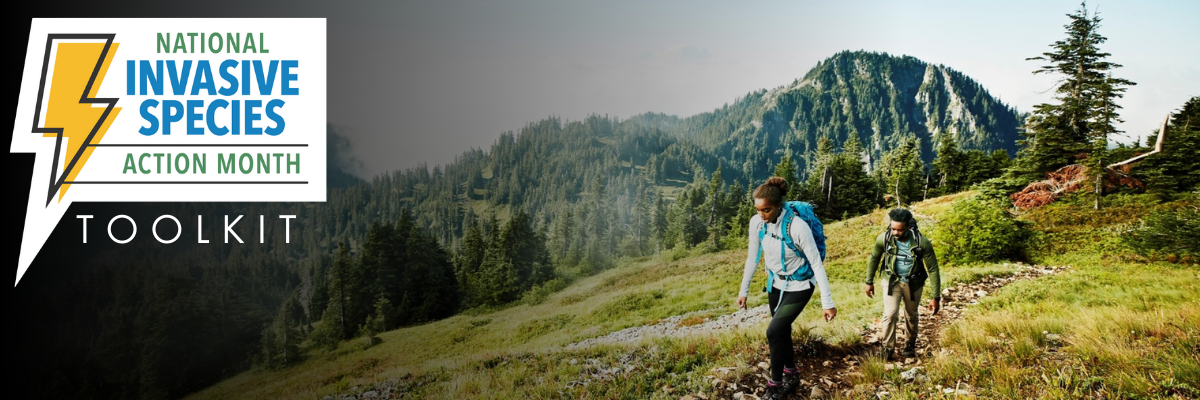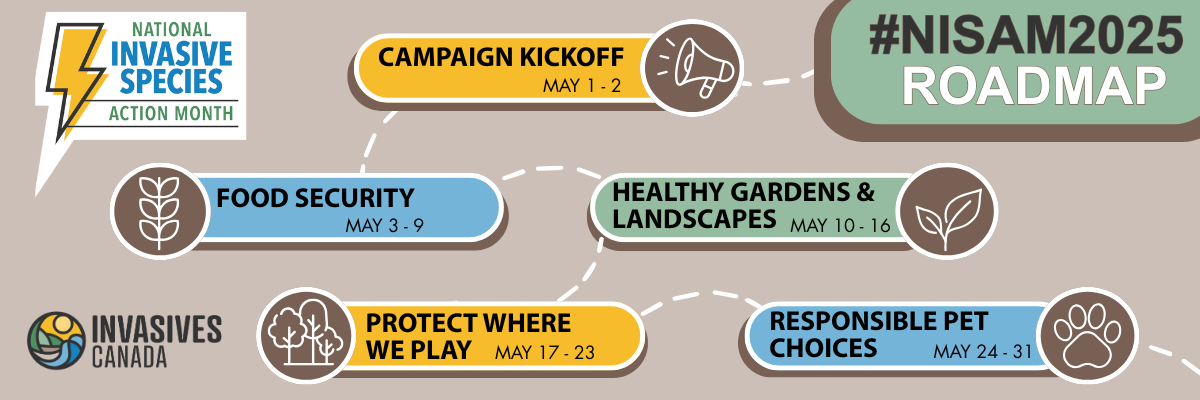This free toolkit is designed to support partners, organizations, and members of the public who wish to take part in National Invasive Species Action Month (NISAM) 2025.
Below, you’ll find everything you need to engage your community—from weekly themes and suggested messaging, to ready-made social posts, outreach tips, and action ideas. Whether you’re sharing content online, hosting events, or simply looking to raise awareness, this toolkit is here to help you amplify the message that small actions can have a big impact!
Guidelines and Tips
Post Design and Imagery:
-
- Download our NISAM2025 Banner PNG to lay over your posts
-
- Find Royalty-Free images at Canva.com, Unsplash.org, Wikipedia Commons or Invasive.org for invasive species images
- Always check for Licenses and list photo credits as require.
- Find Royalty-Free images at Canva.com, Unsplash.org, Wikipedia Commons or Invasive.org for invasive species images
-
- iNaturalist is an incredible resource for finding images.
-
- Make sure the images are ‘Research Grade’ and to check for licenses (found at the bottom of each photo)
Hashtags and Social Media Tags
Hashtags are used to help us track Reach and Engagement in NISAM, and connect invasives species action across the country
-
-
- Use the hashtags #NISAM2025 or #SmallActionsBigImpact on all your Invasive Species Action Month posts.
-
-
-
- If you’re in BC, you can also use ISCBC’s #BCISAM2025 hashtag if you’re posting B.C.-specific content.
-
Tag Invasives Canada in all of you NISAM posts throughout May! This will help us find your posts to interact with and share with our own social network.
-
-
- Tag Invasives Canada on Instagram @InvasivesCanada
-
-
-
- Tag Invasives Canada on Linkedin using @Invasives Canada
-
-
-
- Tag Invasives Canada on Facebook using @CanadianCouncilonInvasiveSpecies
-
Consider tagging relevant partners or local governments in your area to increase visibility and engagement.
Collaborative Posts on Instagram
Instagram collaborative posts allow two users to share the same post or reel, making it visible on both profiles with shared likes, comments, and reach. It’s a great way for partners to boost engagement and co-promote content seamlessly.
If there’s a post/topic you’d like to collaborate with Invasives Canada on (or any other organization), simply “Add Collaborators” when creating a new post and tag @InvasivesCanada. Once they accept the collaboration, the post will go live on both accounts!
It’s best practice to connect with the other user ahead of time to approve content and align on timing, messaging and goals for the post.
National Invasive Species Action Month RoadMap
Campaign Kickoff
Thursday, May 1 – Friday, May 2
Theme: Small Actions, Big Impact!
National Invasive Species Action Month (NISAM) 2025 is Here!
As temperatures warm, more Canadians are going outside to use and enjoy landscapes across the country. May is the perfect month to start promoting action that can help protect these landscapes from invaders. Led by Invasives Canada, National Invasive Species Action Month will feature a different theme each week throughout the month, highlighting the different avenues through which invasive species impact our lives. Whether it’s through food systems, gardening, land and water-based activities, or our furry companions, we’re all affected by invasives species and all have a part to play in stopping their spread. Follow along this month to take action and be a part of a growing movement to protect biodiversity across the country!
Suggested Phrases:
- NISAM 2025 is Here – Join us to help limit invasives spread!
- May is a month for Action! Take part in NISAM 2025.
- Your Small Actions can have a Big Impact on biodiversity!
Actions and Programs to Promote:
- Follow NISAM all month long on social media
- Share NISAM posts throughout the month
- Watch for webinars, local events and other initiatives
- Create your own posts, using the hashtag #NISAM and #SmallActionsBigImpact
Week 1 Pre-Made Posts with Recommended Images
Food Security
Saturday, May 3 – Friday, May 9
Theme: Protecting Farms and Foods
This week, we’re focusing on the connection between invasive species impact the food we put on our plates. Invasive species pose a serious threat to Canada’s food systems by damaging crops, reducing soil quality, outcompeting natives, spreading diseases and driving up pest management costs. The effect is billions of dollars annually in damage and management – of which Canadian farmers bear the burden of these costs. From wild pigs rooting through pastures and transmitting disease, to invasive insects like brown marmorated stink bug and spotted lanternfly devastating fruit crops and grapevines, the impacts are widespread and costly. Safeguarding these food systems starts with us. By staying informed, monitoring for signs of pests, and reporting sightings, we can all help protect Canada’s agriculture and food security.
Suggested Phrases:
- Protect our farms, forests, and food
- Protect what feeds us
- Small actions have Big yields
- Support Canadian Farmers – stop the spread of invasives
Actions and Programs to Promote:
- Squeal on Pigs! Learn more and report wild pig sightings at SquealonPigs.ca
- Play Clean Go! Clean boots and gear before and after spending time in fields, forests, or natural areas
- Learn to identify invasive species in your region
- Download Early Detection and Reporting tools like iNaturalist
- Buy Canadian-grown produce to support our farmers
Week 2 Pre-Made Posts with Suggested Images:
Healthy Gardens and Naturescapes
Saturday, May 10 – Friday, May 16
Theme: Planting for Biodiversity
We can make changes in our gardens that have big impacts on biodiversity! Spring is planting season—and the perfect opportunity to make choices that benefit wildlife and stop the spread of invasives. This week is all about Plant Wise actions: choosing native or non-invasive alternatives, learning how invasives spread from gardens into the wild, and creating landscapes that nurture ecosystems, not harm them. We’ll be highlighting the benefits of planting native, the potential risks of invasive ornamentals, and easy steps gardeners can take to create a more PlantWise garden this spring.
Key Phrases:
- Choose native, grow biodiversity
- Protecting biodiversity starts at home
- Choose PlantWise and protect native species
- Weed out invasives this spring
- Be Plant Wise this spring
Actions and Programs to Promote:
- Choose Native or Non-Invasive plants using your regional Grow Me Instead Guide
- Shop for ornamentals at local native plant nurseries
- Learn how to identify and remove invasive plants like goutweed or periwinkle
- Turn your garden into a pollinator-friendly space by adding shelter and water
- Plant milkweed to support Monarch populations
Week 3 Pre-Made Posts with Suggested Images:
Protect Where We Play
Saturday, May 17– Friday, May 23
Theme: Protecting Landscapes and Waters across Canada.
As the weather warms, more Canadians are heading outdoors to enjoy the country’s natural beauty. But whether you hike, camp, paddle, or fish, outdoor recreation can unintentionally spread invasive species. They hitchhike on boats, firewood, vehicles, and gear—often without us even knowing. This week, we’re highlighting Clean Drain Dry, PlayCleanGO and Buy Local Burn Local actions that help protect Canada’s cherished lands and waters from aquatic invaders and forest pests. With a few simple steps, we can all enjoy the outdoors responsibly and help preserve the places we love for generations to come.
Suggested Phrases:
- Protect the places you love
- Watch for hitchhikers—check your gear
- Burn it where you buy it
- Keep our lakes clear
- Clean gear. Clear trails.
- Take only memories—leave no invasives
- Together, we can keep our forests standing strong.
Actions and Programs to Promote:
- Clean, Drain, and Dry boats and gear after every use
- Properly dispose of live fishing bait
- Remove aquatic plants and mud from boats, trailers, paddles, and gear
- Check regulations and follow watercraft inspection or decontamination requirements
- Buy Local, Burn Local – don’t move firewood
- Burn only local or kiln-dried firewood
- Learn how to identify invasive forest pests and their egg masses
Week 4 Pre-Made Posts with Suggested Images:
Responsible Pet Choices
Saturday, May 24 – Saturday, May 31
Theme: Safeguarding Pets and Biodiversity
Last month was Easter, and it isn’t uncommon for families to gift live bunnies for the holiday. However well-meaning, there’s always a surge of bunny relinquishment in May when the novelty runs off. Pets and aquarium species that are released into the wild can become invasive, harming local wildlife and ecosystems. This week focuses on the Don’t Let It Loose campaign—raising awareness around the risks of ‘letting loose’ bunnies, aquarium species, reptiles, amphibians, or even domestic cats. We’ll share tips on rehoming, surrender options, and choosing pet and plant species responsibly from the start.
Suggested Phrases:
- Love it? Don’t release it.
- Pets belong at home, not in the wild
- Don’t let it loose – you could be breaking the law
- There are always better options than letting it loose
- Protecting wildlife starts at home
Actions and Programs to Promote:
- Don’t Let It Loose – Never release unwanted pets, aquarium and pond contents into the wild
- Research alternatives like pet amnesty or surrender programs
- Learn which pets can become invasive
- PlayCleanGo – keep pets on trail and remove any mud, seeds, or plant pests after hitting the trail
- Equip your cat with brightly-coloured or belled collars to protect birds
Week 5 Pre-Made Posts with Suggested Images:
Contact Us!
If you have questions, need support with content or want to collaborate on a post with Invasives Canada, please reach out to Chris Sullivan at Chris@CanadaInvasives.ca!
Need help in B.C.? Reach out to Craig Stephani at cstephani@bcinvasives.ca.



